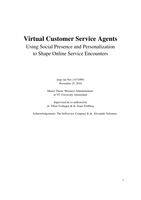Virtual Customer Service Agents
Using Social Presence and Personalization
to Shape Online Service Encounters
Jaap van Nes (1471090)
November 25, 2010
Master Thesis ‘Business Administration’
at VU University Amsterdam
Supervised & co-authored by
dr. Tibert Verhagen & dr. Frans Feldberg
Acknowledgements: The Selfservice Company & dr. Alexander Schouten
1
,1. Introduction
In the digital age, online service encounters are critical to a customer’s image of service
providers and central to determining the success of the firm (Grönroos 2000). These moments
of dyadic interaction between customer and service provider are key since the service
encounter often is the service from the customer’s point of view (Bitner 1990; Czepiel,
Solomon, & Suprenant 1985). Service providers have shaped these online service encounters
to the advantages of the Internet by providing permanent availability of information and
allowing for real-time interaction between customer and company. Through tools like
frequently asked questions (Meuter et al. 2000), live chats (Andrews & Haworth 2002), and
customer communities (Armstrong & Hagel 2000) service providers effectively and
efficiently supply customers with sought-for information. Despite their successful usage the
vast majority of these applications still fail to incorporate two characteristics that are assumed
to be key in delivering an optimal service encounter: feelings of social presence and a sense
of personalization (Bitner et al. 1990; Suprenant & Solomon 1987).
Social presence compasses the feeling of personal, sociable, and sensitive human contact
conveyed through and within a medium (Short et al. 1986; Yoo & Alavi 2001), while sense
of personalization is the extent to which a customer feels the content offered is appropriate,
based on personal information and tailor-made to their needs (Bonett 2001; Lee & Park
2009). Both elements are strongly associated with a customer’s feeling of social and personal
support (Bearden, Malhotra & Uscátegui 1998). More importantly, they represent two
fundamental building blocks of the service encounter as encounters rely heavily on
interpersonal contact (Shostack 1985), are by and large of social nature (Bitner 1990), and
theorized as low tech, high touch moments of truth (Bitner et al. 2000; Drennan & McColl
2
,2003). Due to the distant and computer-mediated nature of the Internet, both elements have
been quite difficult to incorporate in online service encounters.
However, empowered by recent developments in technology a new tool to provide online
service encounters has arisen: virtual agents. Virtual agents, computer-generated characters
able to interact with customers and simulate behavior of human company representatives
through artificial intelligence (Cassell 2000), have been introduced as an alternative way to
provide online service encounters compassing the ability to integrate social and personalized
components. Building on social response theory (Moon & Nass 1995), scholars have put
forward that virtual agents can fulfill the role of service representatives and substitute tasks
historically performed by human service personnel (Meuter et al. 2000). Therefore, virtual
agents prove an exemplary tool to address the lack of interpersonal interaction (Dabholkar
1996; Dabholkar & Bagozzi 2002) found online and to elicit feelings of social presence and
senses of personalization, thereby responding to the call for integration between technology
and personal aspects of online service delivery (Berry 1999).
Despite the suggestion that virtual agents are able to represent elements previously unfeasible
in online service encounters, research has not yet empirically investigated how virtual agents
can be employed to shape and improve online service encounters. Moreover, although it has
been noted that virtual agent impressions affect consumer processing (e.g. Keeling et al.
2010; Nass & Moon 2000), research on virtual agents thus far disregarded the question
whether elements historically shown to be at the heart of service conception, i.e. social and
personalized contact between the customer and service provider, are also central elements in
online service settings. In this study we aim to answer these intriguing research questions.
3
, In an attempt to adapt elements from traditional customer service literature to shape online
customer service encounters by virtue of virtual agents we focus our inquiry on three
classical service agent characteristics: friendliness, expertise, and smiling, and the moderating
roles of anthropomorphism and communication style on service encounter evaluation. The
impact of these agent characteristics is explicated through the use of several streams of
research, such as implicit personality theory (Anderson 1995), the theory of primitive
emotional contagion (Hatfield et al. 1994), social response theory (Moon & Nass 1995), and
social interaction theory (Ben-Sira 1980).
Our decision to select friendliness, expertise, smiling, anthropomorphism, and
communication style was backed up both theoretically and rooted in practice. Being polite,
responsive, helpful and understanding is claimed a paramount property of service delivery
(Price et al. 1994), as is possessing the required skills and being knowledgeable about the
service (Parasuraman et al. 1985). Yet, despite, or perhaps due to, their general and widely
applicable nature friendliness and expertise are only occasionally employed as predictive
variables and research on their role in online service encounters is limited (Witkowski &
Thibodeau 1999). Moreover, literature on the importance of serving customers with ‘an
American smile’ is redundant (e.g. Hennig-Thurau et al. 2006; Pugh 2001), but little research
is conducted on whether smiling service representatives elicit the same responses when the
interaction is mediated by technology and with a computer-generated character. From a
practical perspective the interaction between the three agent perceptions allows consumers to
get a complete impression, both verbally and non-verbally, of the agent by appraising what
(expertise), how (friendliness) and with what emotion the agent delivers the service.
4





